In electrical and electronic circuits, there is an active element that provides necessary excitation in the circuit. This element is known as a source. In terms of electrical engineering, a source represents a device that can generate electrical energy to do some work in an electric circuit. Electrical energy sources can be broadly classified into two main types namely, voltage sources and current sources.
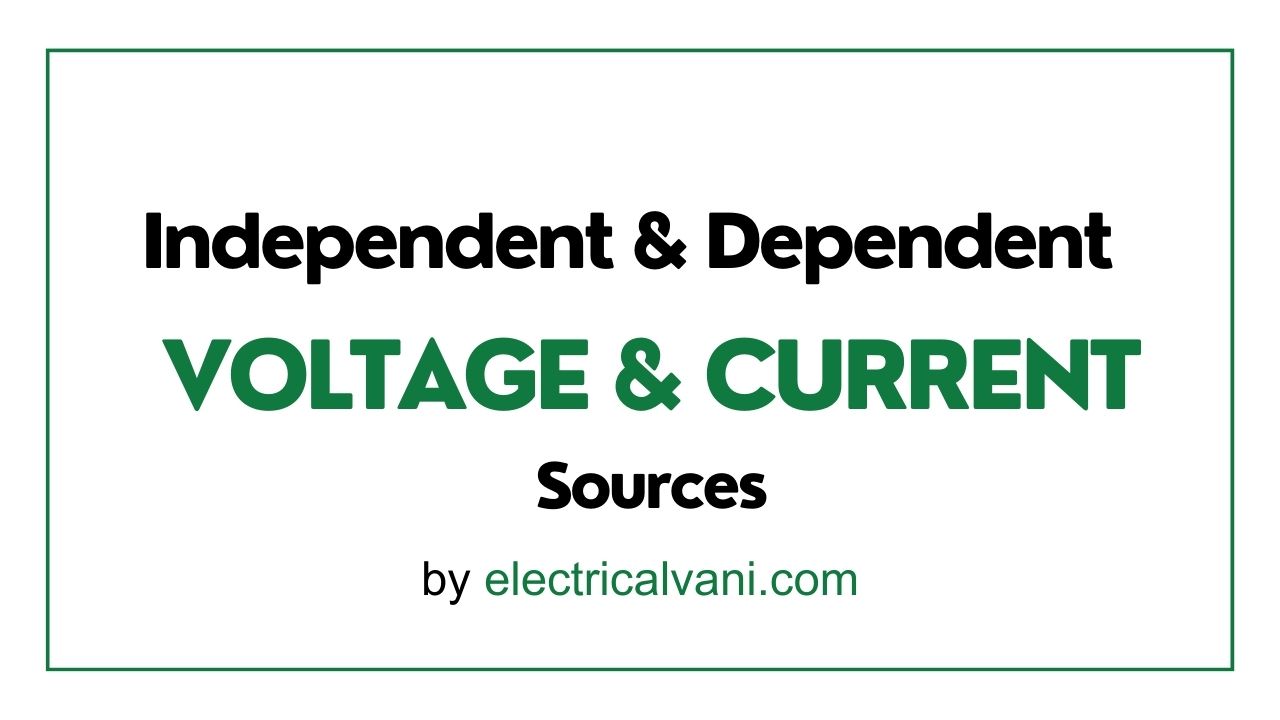 In this article, we will study different types of voltage and current sources. Let’s start with the classification of sources.
In this article, we will study different types of voltage and current sources. Let’s start with the classification of sources.
Classification of Sources
In electric circuits, the electrical sources can be classified into the following types:

Let us now discuss each type of source in detail.
Voltage Source
A voltage source is a type of active element used in electrical circuits to produce a consistent voltage or potential difference between two points or across two terminals.
In other words, a voltage source is a type of electrical element that produces a constant or variable voltage across its terminals.
Some common examples of voltage sources are cells, batteries, generators, etc.
There are two types of voltage sources namely,
- Independent voltage sources
- Dependent voltage sources
Current Source
A current source is another type of active element that provides a certain amount of current in a circuit. The current provided by a current source can be a constant magnitude current or a variable magnitude current.
Some common examples of current sources are transistors, photoelectric cells, and other semiconductor devices.
Current sources can be also classified into two types i.e.,
- Independent current sources
- Dependent current sources.
Independent Voltage Source
An independent voltage source is a type of voltage source whose value of voltage does not depend on any other voltage or current in any other part of the circuit.
In other words, when the value of a voltage source is not a function of any other voltage or current in the circuit, then it is called an independent voltage source.
The independent voltage sources can be further classified into the following two types:
- Ideal voltage sources
- Practical or real voltage sources
Dependent Voltage Source
A dependent voltage source is a type of voltage source whose value of output voltage depends on a voltage or current in any other part of the circuit.
Hence, the value of the voltage of the dependent voltage source varies with any change in the voltage or current in the circuit.
There are two types of dependent voltage sources, they are
- Voltage-dependent voltage source (VDVS)
- Current dependent voltage source (CDVS)
Independent Current Source
An independent current source is an active circuit element whose output current does not depend on the current or voltage in any other part of the circuit.
In other words, a type of current source whose output current is not affected by any change in the load circuit to which it is connected, then this type of current source is called an independent current source.
The independent current sources can be classified into the following two main types:
- Ideal current sources
- Practical or real current sources
Dependent Current Source
A dependent current source is a type of current source whose output current depends on or is controlled by an electric current or a voltage in any other branch of the circuit or across an element somewhere else in the circuit. It is also known as a controlled current source.
Depending on the controlling quantity, the dependent current sources are classified into the following two main types:
- Voltage-dependent current sources
- Current dependent current sources
Ideal Voltage Source
An ideal voltage source is a type of independent voltage source that produces a constant voltage across its terminals and its output voltage is independent of the current drawn from it.
The circuit symbol of the ideal voltage source is shown in the following figure.
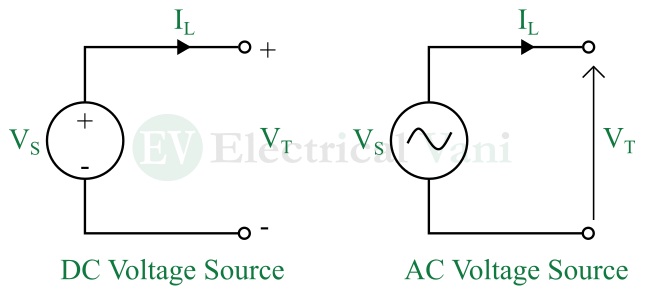
Therefore, for an ideal voltage source, we have,
$$V_T = V_S$$
It is important to note that an ideal voltage source has zero internal resistance or impedance.
Since there is no internal resistance in an ideal voltage source, hence its output voltage always remains constant as shown in the following figure.

Practical Voltage Source
A practical voltage source is a type of independent voltage source whose output voltage decreases with the increase in the current drawn from it.
This decrease in the terminal voltage is due to an increase in the internal voltage drop across the internal resistance or impedance of the source.
A practical or real voltage source is depicted as an ideal voltage source with a small series resistor (Rin) as shown in the following figure.

Hence, the terminal voltage of the practical voltage source is given by,
$$V_T=V_S – IR_{in}$$
It is important to note that the voltage across the terminals of a practical voltage source decreases with the increase in the current taken from it. This relationship between current and voltage is shown in the following figure.
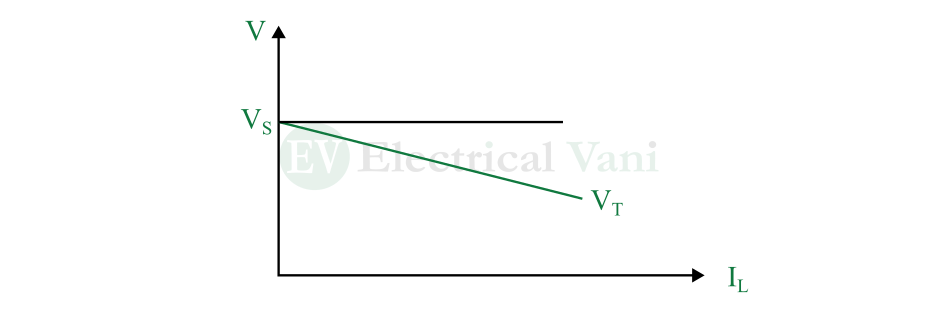
Ideal Current Source
An ideal current source is a theoretical model of an independent current source having infinite internal resistance and producing a constant output current throughout its operation which is not affected by the voltage across its terminals.
The circuit symbol of the ideal current sources is shown in the following figure.
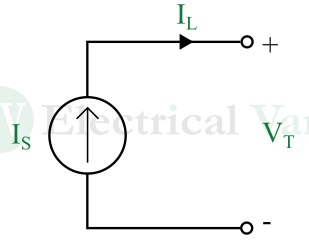
From this figure, the load current of the ideal current source is equal to the source current, i.e.,
$$I_L = I_S$$
The output current of an ideal current source always remains constant and is not affected by the load conditions or terminal voltage. This current-voltage relationship of an ideal current source is shown in the following figure.
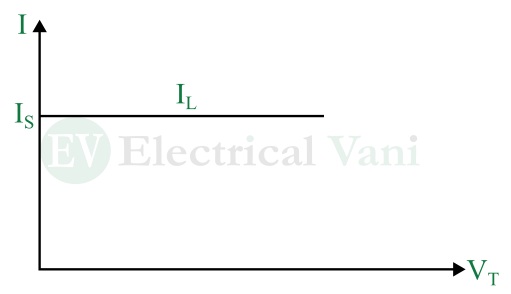
Practical Current Source
A practical current source is a real-world active element used to supply a certain amount of current in an electric circuit. A practical current source is represented as an ideal current source with a large parallel resistance as shown in the following figure.
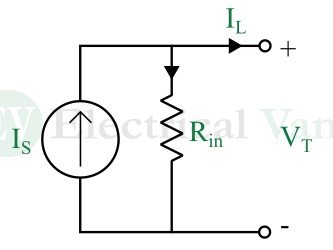
For a practical current source, the load current is not equal to the source current, but it is given by,
$$I_L=I_S-\left(\frac{V_T}{R_{in}}\right)$$
Hence, some part of the total source current (IS) flows through the internal resistance connected in parallel. With the increase in the terminal voltage, the current through internal resistance also increases which reduces the load current.
The current voltage characteristic of the real current source is shown in the following figure.
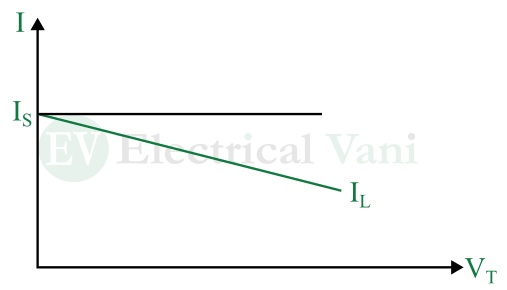
Voltage-Dependent Voltage Source
The voltage-dependent voltage source (VDVS) is also known as the voltage-controlled voltage source (VCVS). It is a type of voltage source whose output voltage is controlled by another voltage across an element connected in the circuit.
The circuit symbol of the voltage-dependent voltage source is shown in the following figure.
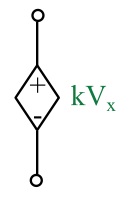
Here, k is constant and Vx is the controlling voltage across an element connected somewhere else in the circuit.
Current Dependent Voltage Source
The current-dependent voltage source (CDVS) is also known as the current-controlled voltage source (CCVS). It is a type of voltage source whose output voltage is controlled by a current flowing in any other branch of the circuit.
The circuit symbol of a current-dependent voltage source is shown in the following figure.
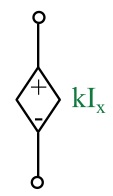
In this case, the k is a constant and Ix is a current that controls the output voltage of the voltage source.
Voltage-Dependent Current Source
The voltage-dependent current source (VDCS) is also known as the voltage-controlled current source (VCCS). It is a type of current source whose output current is controlled by a voltage across an element connected somewhere else in the circuit.
The circuit symbol of the voltage-dependent current source is shown in the following figure.
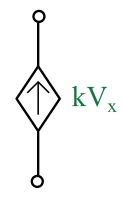
Here, k is a constant and Vx is the voltage across an element that controls the output current of the current source.
Current Dependent Current Source
The current dependent current source (CDCS) is also known as a current controlled current source (CCCS). It is a type of current source whose output current is controlled by a current flowing through any other branch of the circuit.
The circuit symbol of the current-dependent current source is shown in the following figure.
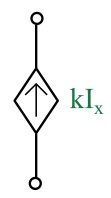
Here, k is a constant and Ix is the current in a branch of the circuit that controls the output current of the current source.
Conclusion
In this article, we have learned about all types of independent and dependent voltage and current sources. The independent and dependent voltage sources are active circuit elements used in electric circuits to provide necessary excitation. If still you have any questions related to this topic, let me know in the comment section. I will answer as soon as possible.